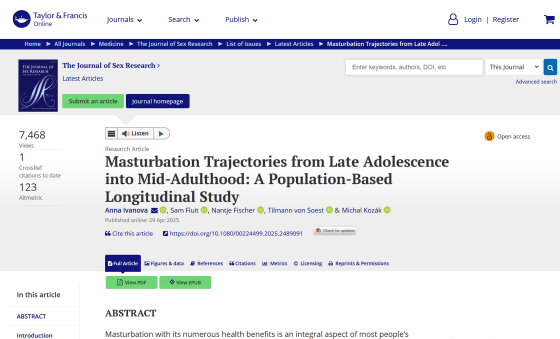Masturbation habits change with age, remaining stable for men from age 19 to 50, but peaking in women's early 30s

While not everyone engages in masturbation, it's an important aspect of the sex lives of both men and women. A long-term study of more than 2,500 participants revealed how masturbation habits change with age.
Full article: Masturbation Trajectories from Late Adolescence into Mid-Adulthood: A Population-Based Longitudinal Study

New longitudinal study reveals how masturbation habits evolve from young adulthood to midlife
https://www.psypost.org/new-longitudinal-study-reveals-how-masturbation-habits-evolve-from-young-adulthood-to-midlife/
Masturbation is common and healthy for humans, but it has been less studied than partnered sex. Most existing studies on the topic are cross-sectional, capturing a single point in time, and it's unclear how masturbation habits change with age in specific individuals.
Scientists have also debated the relationship between masturbation and partnered sex. One theory, the 'compensatory model,' suggests that masturbation increases when partnered sex is scarce, while another, the 'complementary model,' suggests that masturbation complements active sex. Additionally, some have proposed that masturbation is an autonomous behavior completely separate from sex.
A research team from the University of Oslo in Norway used data from a long-term follow-up of specific individuals to examine changes in masturbation behavior with age. The data used for the study was from the Young in Norway study , which followed Norwegians from their teenage years, and this time focused on a sample of 2,562 people.
The data used survey responses collected from participants at three different times. This rich dataset allowed the research team to model changes in masturbation frequency from age 19 to 50.
Participants provided information about their masturbation frequency, as well as their experiences with partnered sex and sexual fantasies . They also answered questions about their relationship status, whether they had children, their sexual identity, their educational background, and their religious affiliation. The researchers used a statistical method called multilevel modeling to examine how masturbation behavior changed over time and how various factors influenced these patterns.

The analysis first revealed differences in masturbation patterns between men and women. For women, the frequency of masturbation gradually increased from the age of 19, peaked around age 31, and then began to decline slowly. For men, on the other hand, the frequency of masturbation remained fairly stable across all age groups from 19 to 50.
Next, we examined the effect of the frequency of sex with a partner on the frequency of masturbation, and found no significant change in the frequency of masturbation for either men or women. This result supports the theory that masturbation is not a substitute for or a complement to sex with a partner, but rather an autonomous activity that serves as a goal in itself.
When other factors were taken into account, a more complex pattern of change was observed. While the frequency of masturbation among men appeared stable, when the frequency of sexual fantasies was taken into account, there was a trend toward a decrease in masturbation between the ages of 19 and 36, followed by an increase thereafter. A similar pattern was observed when partner status was taken into account, with masturbation decreasing toward the mid-30s. However, no significant changes were observed for women, even when sexual fantasies or partner status were taken into account.
Furthermore, the frequency of masturbation among childless subjects increased significantly until around age 30, after which there was a sharp decline. Other findings include that subjects who identified as non-heterosexual masturbated more frequently than heterosexuals, no difference in masturbation frequency was found based on educational level, and religious beliefs influenced the low frequency of masturbation among women at age 19.

The study relied solely on self-reporting, which may be influenced by imperfect memory or embarrassment surrounding sensitive topics. Furthermore, the participants were all Norwegian and born in the 1970s, so results may differ across different eras and cultural contexts.
The research team suggested that future studies could look more closely at the dynamic interplay between partnered sex and masturbation, particularly the influence of relationship quality and an individual's level of libido.
Related Posts:
in Science, Posted by log1h_ik







